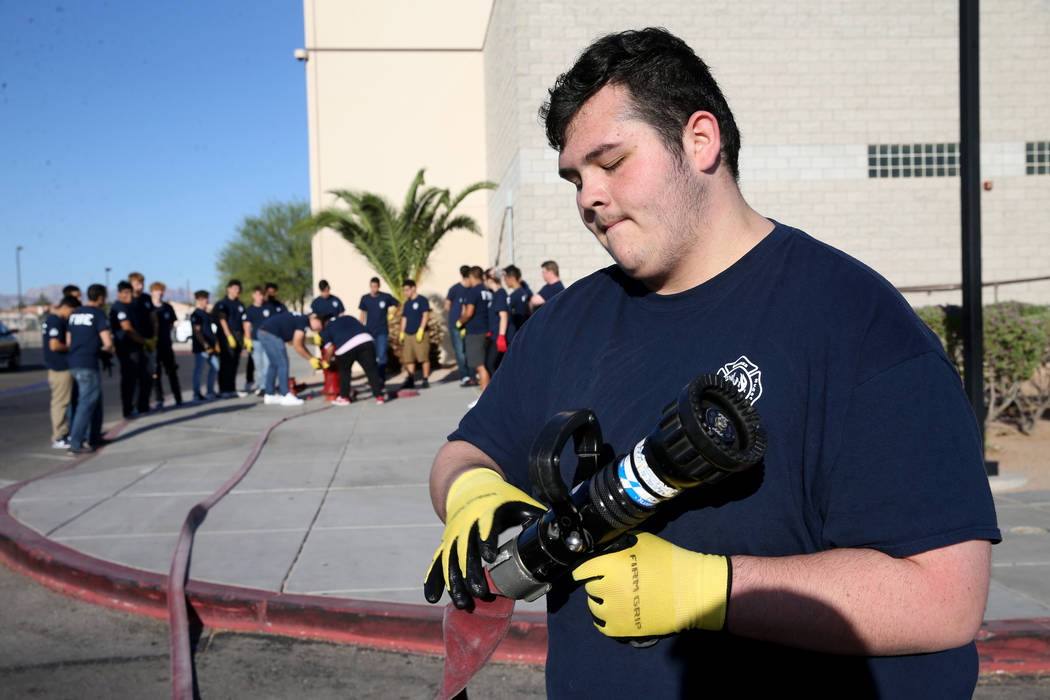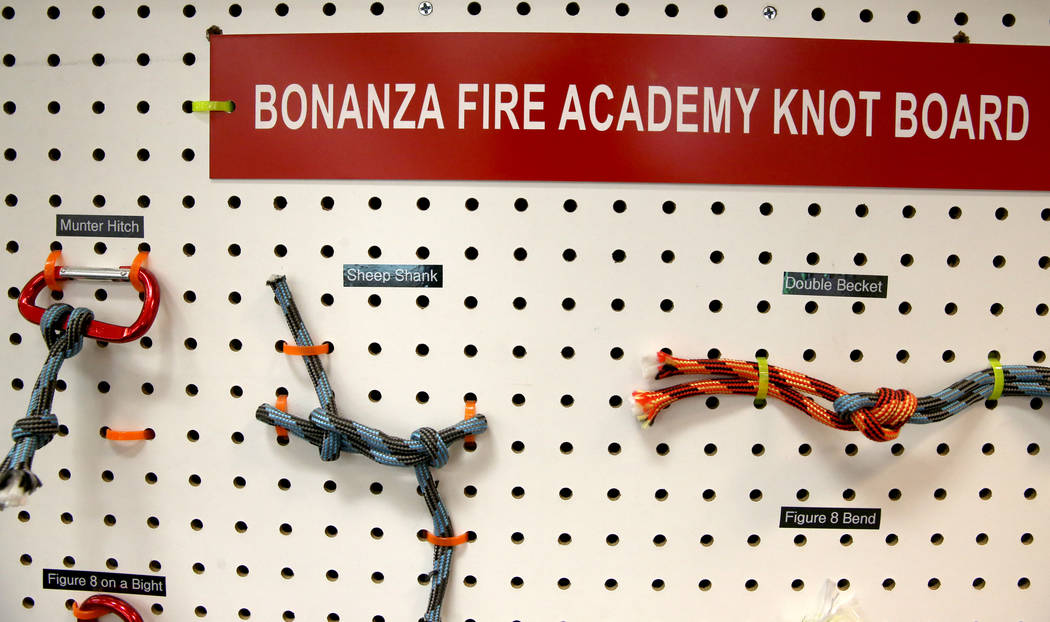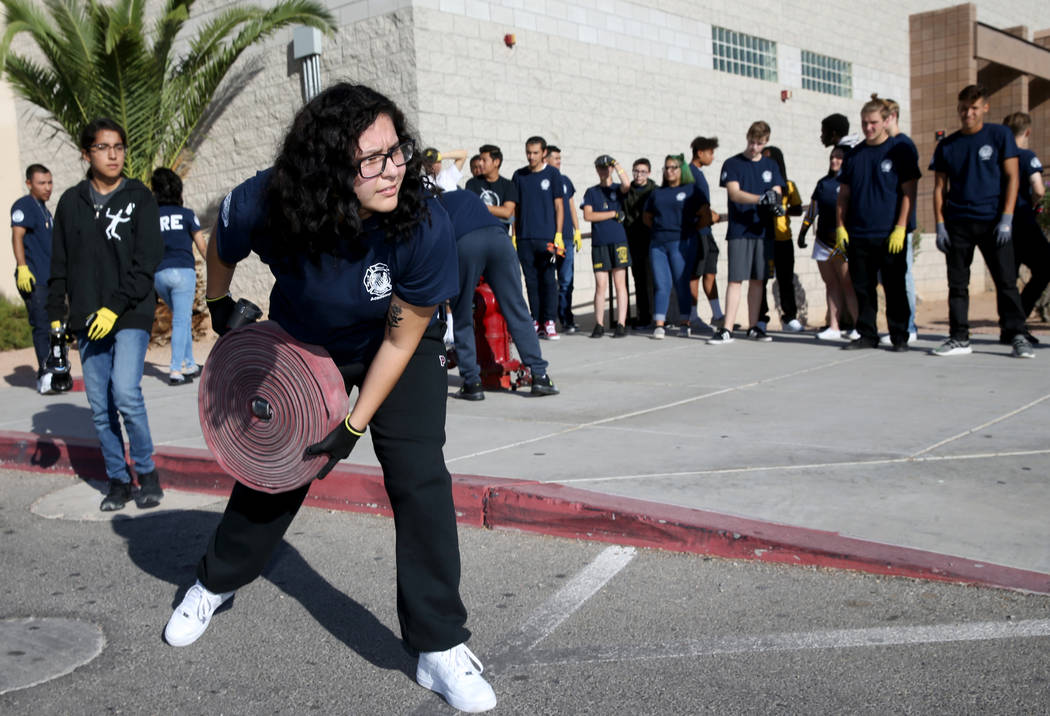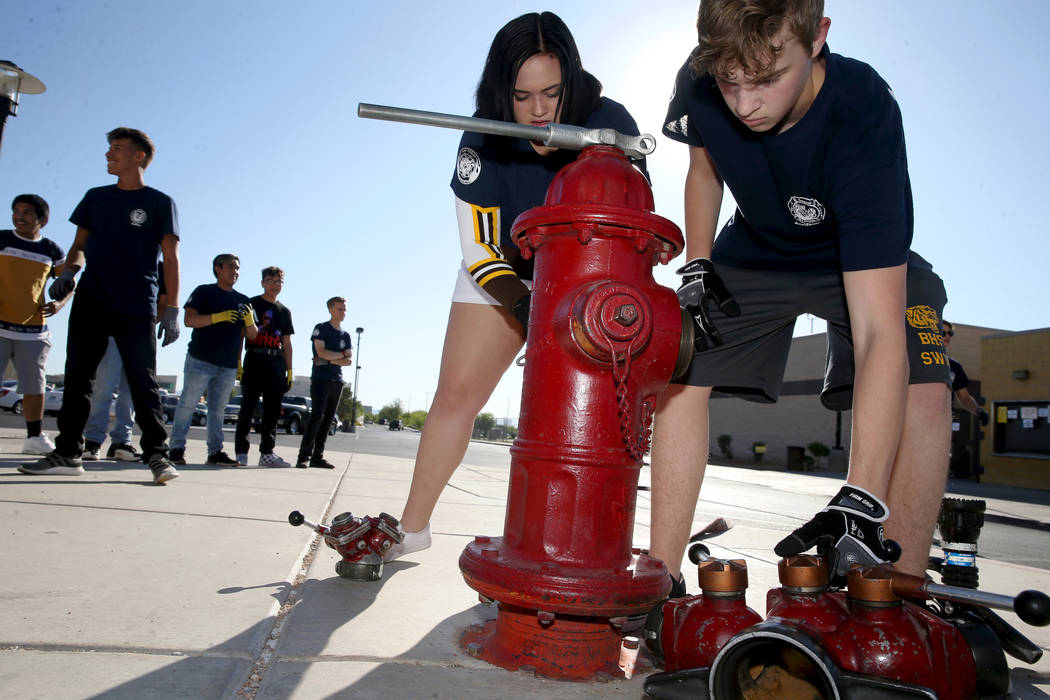Las Vegas Fire Department awarded for education partnership
Students wearing yellow and black gloves unscrewed a nozzle from a fire hydrant Sept. 27 outside Bonanza High School’s gymnasium.
As fire science teacher Christopher Batterman watched, the teenagers attached a fire hose. Then, they practiced throwing a neatly wrapped hose onto a campus road to unroll it.
Through a partnership with the Las Vegas Fire Department, the Bonanza High School Fire Science Academy — part of the Clark County School District — started in 2010. The program is designed to give students the skills and certifications they need to pursue a fire service career.
“It gives them everything they need to compete with anyone out there to get a job on the department,” Batterman said.
The fire department has donated more than $2 million in equipment to the program and helped develop curriculum. It also regularly sends fire personnel — Station 6 is across the street from Bonanza High — to the academy to help out.
Those efforts have garnered national attention.
The fire department recently won a Business-Education Partnership Award from the national Association for Career and Technical Education. The award is set to be presented Dec. 4 during a conference in Anaheim, California.
The fire department is an awesome partner, Batterman said, adding he’s constantly talking with the department — and especially with former students who now work there.
The partnership benefits the fire department and it’s good to get students thinking about careers in the fire service, said Fire Chief Willie McDonald.
“We’re very honored and very humbled by the fact that we were recognized, along with Bonanza High School’s program,” he said.
More than 1,200 students have graduated from the Fire Science Academy. By the time they finish the program, they have CPR, first aid, Community Emergency Response Team (CERT) and Federal Emergency Management Agency (FEMA) certifications in hand.
More than three dozen alumni now work for Las Vegas-area fire departments, Batterman said, and others work for a fire department elsewhere, as a wildland firefighter or emergency medical technician.
Creating the academy
Batterman, who previously worked in firefighting, helped create the Fire Science Academy with then-fire department Chief Greg Gammon. They wrote a state curriculum for fire science that is now used nationwide, Batterman said.
The academy has 210 students in six classes. Many won’t end up becoming firefighters, Batterman said, but he noted the program is also relevant to other career options such as law enforcement and emergency medical services.
Fire Science Academy students earn college credits through the College of Southern Nevada, but the program emphasizes helping students find a job right out of high school.
“I tell these students, ‘Don’t go to college unless you have to,’” Batterman said.
Graduating from the Fire Science Academy dramatically improves opportunities for participating young people, McDonald said.
For graduates, one option is joining — if they haven’t already — the Las Vegas Fire & Rescue Explorer Program. It’s open to those ages 15½ to 25 who are interested in a fire science career.
“Those folks are included in some community outreach activities and help support events,” McDonald said.
If Fire Science Academy graduates meet requirements — such as being at least 18 years old, having a driver’s license and high school diploma, and being an emergency medical technician — they can apply for a firefighting job.
If they go through the application and testing process and are offered a job, they participate in a rookie fire academy that typically lasts nearly six months.
Batterman said he advises students to work to become an EMT during their senior year of high school — Bonanza High has a program — or after graduation, and then to work as an EMT until they get hired by a fire department. Students must be at least 18 to take the national EMT certification exam.
A valleywide draw
During a skills exercise Sept. 27, Batterman instructed a group of juniors and seniors in an advanced-level class: Always stand behind the fire hydrant when you open it up.
The exercise wasn’t timed, and students were working in groups. But eventually, each student will have to work alone and will have just 2½ minutes to complete the task.
Jacob Perez, 18, joined the Fire Science Academy “’cause it’s fun, hands-on and active,” he said. He wants to become a firefighter and said his second choice — if firefighting doesn’t work out — is going into the military.
With the Fire Science Academy, “this whole thing is about team building,” Perez said, noting it also helps students prepare for life after high school and learn how to function in the community.
Julie Mendez, 18, was thinking about becoming a police officer but received a recommendation to join the Fire Science Academy.
Celeste Pineda, 17, said she likes learning hands-on skills, adding, “You can take your experience anywhere.”
Some Fire Science Academy students don’t live within Bonanza High’s attendance zone but transfer to the school to participate in the program. Batterman even has one student from California whose family moved to Las Vegas so he could enroll.
Younger students spend more time in the classroom. But by their final year in the program, students do hands-on skills training three or four days a week. They have to get signed off on 110 skills after demonstrating proficiency.
Bonanza’s program has evolved to emphasize some areas — such as preparing for the physical fitness test necessary to become a firefighter — more than others. And the fire department provides a chance for students to get an inside look at what it takes to be a firefighter.
Each year, three of the top students in the Fire Science Academy spend several hours shadowing on-duty chief officers for the fire department, including observing at a fire station and riding along on calls.
Contact Julie Wootton-Greener at jgreener@reviewjournal.com or 702-387-2921. Follow @julieswootton on Twitter.



































